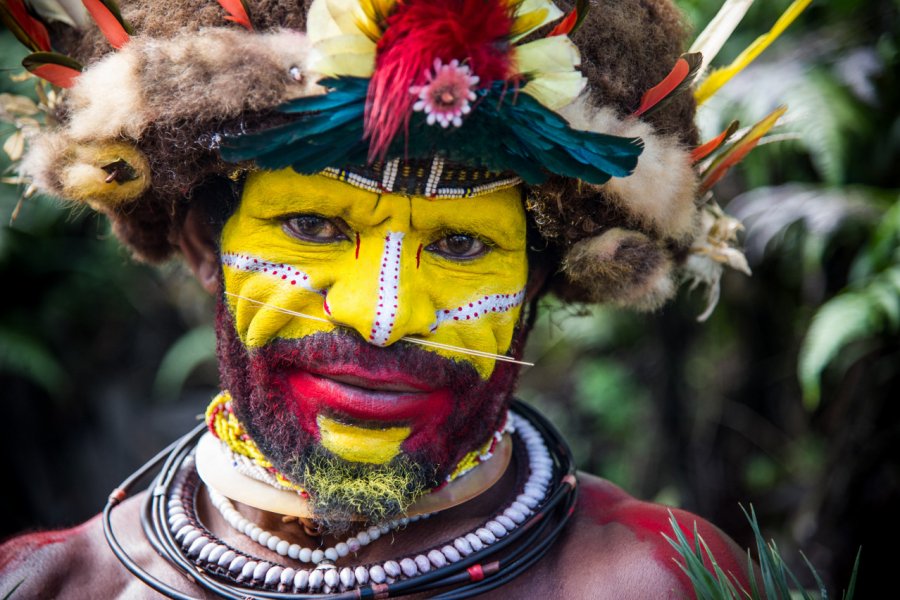Travel Guide Tari
Find an accommodation
Advertising
Tari was long the end of Papua, a final station on the Highlands Highway. The town of Tari consists of a street that runs along the airport, with a few shops and a vague supermarket where there is little other than the basic products used by the Promise. Tari becomes extremely animated on Monday and Friday, days of large market coinciding with Air Niugini flights. But no matter what the day, you don't have to walk alone. First of all, because of pickpockets, but especially because the atmosphere is very buzzing, the Huli being famous for their warlike manners. Tribal wars remain frequent in the region and cause deaths every year. Crowd movements in particular can be dangerous. As in Papua New Guinea, the population will be extremely welcoming to the visitor and many indigenous people will spontaneously speak to him, accompany him for a moment or invite him a few days in their village. Although most of the time, it is a valuable opportunity for unforgettable encounters and incursions into the culture of Des, we need to know how to use the common sense when deciding whether or not to follow his new friends. In the coming years, Tari is expected to undergo significant changes due to an already well advanced project of oil and gas extraction within a few kilometres of the station. The impacts on Tari in terms of access and infrastructure seem obvious. A multi-lane road leading to the future extraction zone is under construction, a new airport is planned and the LNG project will directly affect the region. The fact remains that the Huli will make this "chance", given the negative aspects necessarily involved in a mining project.The "Huli wigmen" are famous for their wigs (wig means wig in English; wigmen, hommes). These, worn proudly and embellished with a complicated and codified assemblage of feathers, are made from their owner's hair in complex initiation rites. Once, at the age when the beard grows on her chin, a young man was subjected to an initiation in order to gain full status and marry. He then joined secret camps in the forest, accompanied by shamans and other insiders, who inculquaient everything a warrior and father of family had to know to take care of his clan, his land and his family. He also learned to behave as a respectable man in a highly regulated and economically poor society. For the duration of this initiation, or for several months, young men should not see, or be seen, women, especially never touch them, or come into contact with objects that they would have touched. The paths they lent were reserved and if, by bad luck, they had no choice but to take an item touched by a woman, they took the precaution of putting around a sheet before to seize it… Women reported by far their presence by shouting or singing and left traces of their passage. Taboos about food were also numerous, insiders eating only "dry" food, such as taro and sweet potatoes baked with fire. Never vegetables, cuisson and even less meat or fat… But the main concern was to grow their hair in shape of wig. The maintenance of the hair in charge of the shamans required daily watering with "magic water", water impregnated with plants and on which certain formulas were pronounced. This water was supposed to provide strength and vitality to the capillary mass, which then WAS grew faster. At the end of this process, the boys were undergoing a "pass examination". Then a party, lined with a pig feast, celebrated their return to the community and their new human status. Unless we get married immediately, the new insider then decided to pursue new initiation cycles, sanctioned by new forms of wigs (four models in all), all giving a little more prestige within the community. The fourth wig, in the form of Napoleonic bicorne, pointed to a valiant man who was subjected to the entire initiation and who was going to occupy an important place in his clan. Nowadays, initiation rites have been considerably simplified, but many boys continue to "push" their wigs, if only to be able to participate in "singsing," sources of prestige, financial income and, why not, women's conquests… A meeting with the Huli is one of the strongest experiences of Papua New Guinea, so their character is unique and their culture strong. A stay in a village will allow you to visit their sweet potatoes, grown in typical mounds, and discover the special social organisation of the Huli. Men live in "houses of men", while women's homes, one per family, are scattered in the fields. The alternation of sharp mountains and marshy plains is worth beautiful landscapes, very photogenic. There are even more pigs here than elsewhere and sweet potatoes are still unavoidable. However, the isolation of the region prevents any comfort and, apart from the Ambua Lodge, which belongs to Trans Niugini, no accommodation can guarantee its customers electricity or hot water .
What to visit Tari?
Advertising
Suggested addresses Tari
Weather at the moment
Advertising
Organize your trip with our partners Tari
Transportation
Book your plane tickets
Car Rental
Boat rental
Accommodation & stays
Find a hotel
Holiday rental
Find your campsite
Tailor-made trip
Immersion travel
Services / On site
Activities & visits
Find a doctor







